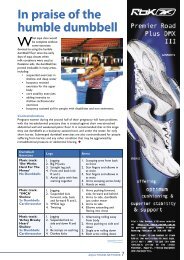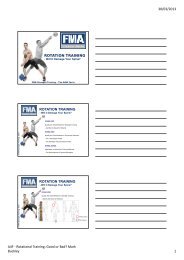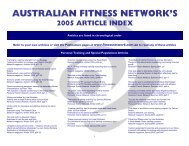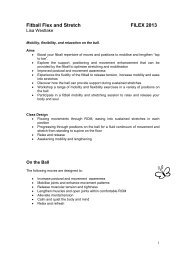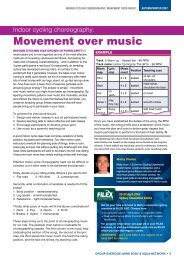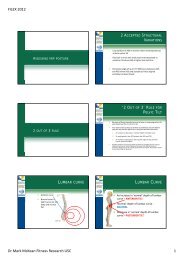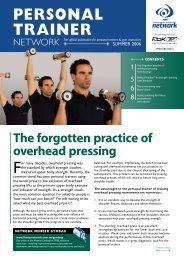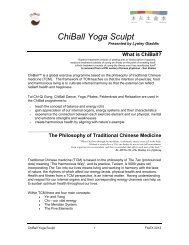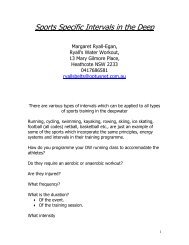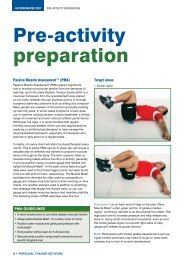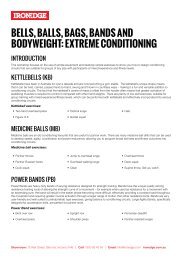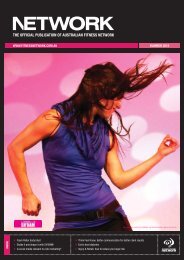CD - Australian Fitness Network
CD - Australian Fitness Network
CD - Australian Fitness Network
You also want an ePaper? Increase the reach of your titles
YUMPU automatically turns print PDFs into web optimized ePapers that Google loves.
that client will often ask the all-important question, ‘Why<br />
would I bother going through all that again when I already<br />
know that I will get to a point where I can’t keep going and<br />
I’ll feel like a failure and hate myself?’. ‘Why bother’ syndrome<br />
can arise in relation to various aspects of our lives. It can<br />
happen with diets, weight loss and exercise programs as well<br />
as career, relationship, self esteem and many other issues.<br />
Some clients feel acute embarrassment about;<br />
• how much they weigh<br />
• how their body looks<br />
• their inability to keep up with others in an exercise class<br />
• real or imagined expectations of their personal trainer.<br />
All of these conditions can turn someone away from the<br />
very things that would help them achieve increased selfesteem<br />
and more joy – a good exercise and nutrition program<br />
that is right for them. Fortunately, these conditions, and more,<br />
can be treated with EFT.<br />
One of the biggest surprises people have when learning<br />
about EFT is the ease with which cravings or urges for<br />
food and drink can be decreased. A favourite EFT group<br />
demonstration of mine involves giving everyone a piece of<br />
chocolate and then leading them through an EFT routine<br />
to release the urge to eat that chocolate. First they smell<br />
the chocolate. Next, in order to heighten their craving for<br />
the chocolate before they do EFT, they taste the chocolate.<br />
During one session, after only fi ve minutes of doing EFT, one<br />
participant stated that he could not remember not wanting<br />
chocolate before. His craving was totally gone. Not only can<br />
cravings be eliminated, after doing EFT for a few minutes,<br />
clients are often asked to smell and taste the chocolate. More<br />
than 50 per cent – and sometimes as many as 80 per cent – of<br />
the group typically says that it does not smell or taste as good<br />
as it did prior to EFT.<br />
Using EFT on cravings is a fi rst step to releasing addiction.<br />
It is also important when working with addiction to eliminate<br />
whatever is actually creating the urge to begin with. It is easy<br />
to think the addiction is the problem, whereas in fact, it is<br />
the distraction from the problem. At the core of addiction<br />
is almost always a ‘feeling’ that the client does not want to<br />
experience. High on the list of these feelings are negative and<br />
false beliefs about themselves and the world. Sometimes with<br />
addictions there is a specifi c pattern involved. Many smokers,<br />
Location of the acupoints used in Emotional Freedom Techniques<br />
for example, want to smoke after a meal or fi rst thing in the<br />
morning. If the client has an addiction, it is wise to work with<br />
more than simple cravings and to initially have the guidance<br />
of a skilled EFT practitioner.<br />
NETWORK WINTER 2010 www.fitnessnetwork.com.au<br />
SPECIAL FEATURE<br />
EFT is not limited to fi tness training and addiction, but can<br />
also be used to overcome anxiety, panic attacks, depression,<br />
relationship issues and many other emotional issues. It can be<br />
used to help fi tness trainers and other small business owners<br />
obtain greater success and income from their business.<br />
There is a mantra in the world of EFT which goes ‘Try it on<br />
everything!’<br />
EFT is the fastest growing energy psychology technique in<br />
the world today and for good reason. It is powerful yet gentle,<br />
it can be learned by young and old alike and the best part – it<br />
often works when nothing else does.<br />
Want to know more?<br />
For more information about Maggie and EFT visit<br />
www.maggieadkins.com.au<br />
<strong>Network</strong> is willing to publish more articles on this and<br />
other alternative health and wellbeing strategies if there<br />
is suffi cient member interest. Email the editor Oliver<br />
Kitchingman at oliver.kitchingman@fi tnessnetwork.com.au<br />
to let us know your thoughts.<br />
Image courtesy of Marcus Wieman and Gerald Stiehler, via Wikimedia Commons<br />
53



